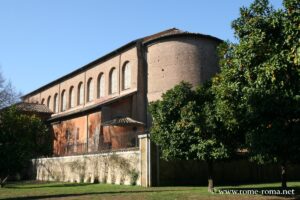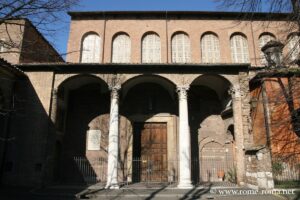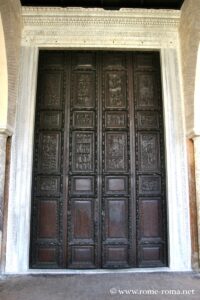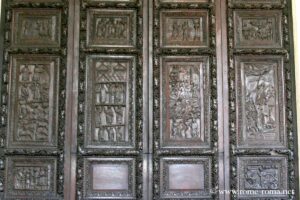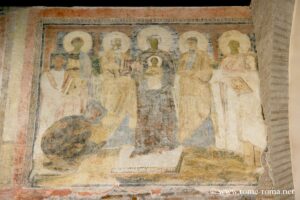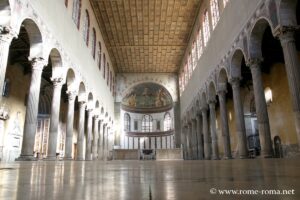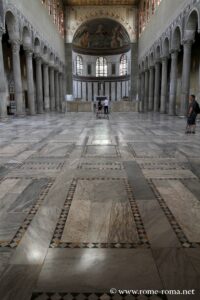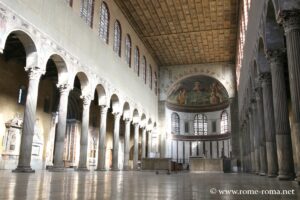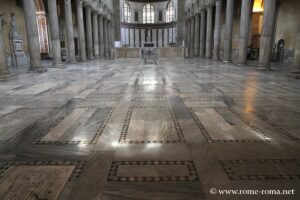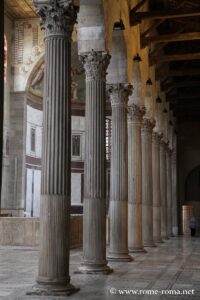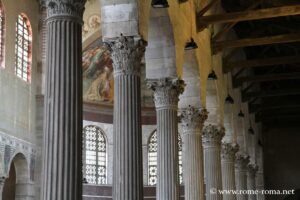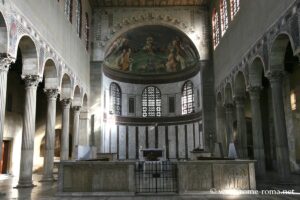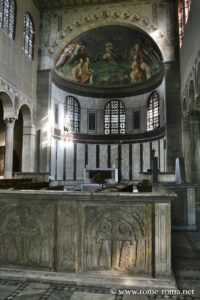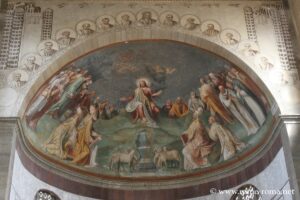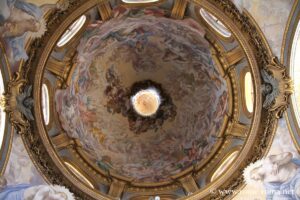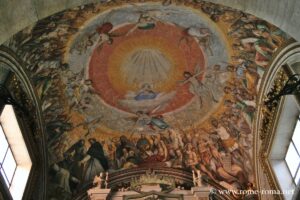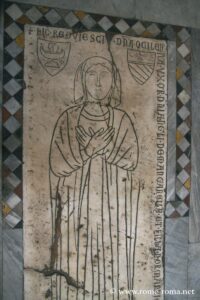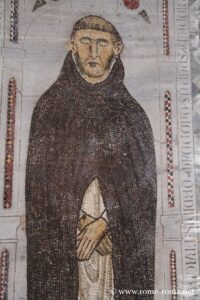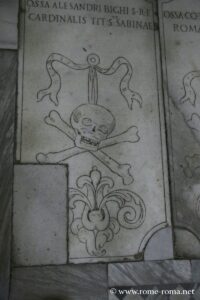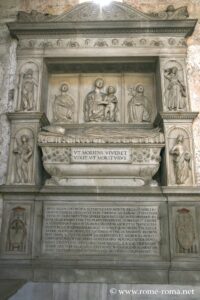The Church of Santa Sabina, dedicated to Saint Sabina of the Aventine, is one of the most remarkable early Christian basilicas in Rome that have been preserved. It was built in the 5th century near an ancient temple of Juno.
Today, it serves as the seat of the Curia of the Order of Preachers, the Dominicans.
The building underwent several restorations and was altered in the 16th century by the closure of nearly twenty of its windows.
Early 20th century campaigns restored part of its original appearance. Its interior, sober and harmonious, displays balanced proportions. It retains some remarkable remnants, such as a wooden door dating back to the 5th century.
History of the Basilica of Santa Sabina on the Aventine
The church was built by the priest Petrus of Illyria, originally from Dalmatia, between 422 and 432 on the site traditionally associated with the house of Sabina, a Roman matron later venerated as a saint, likely a Christian adaptation of a local legend rather than a historically attested figure. Her cult is documented from the 5th century. Inscriptions discovered nearby attest to the existence of the Temple of Juno Regina, nearly 24 columns of which were reused in the construction of the basilica.
In the 9th century, the church was integrated into the imperial fortifications, and the current bell tower dates from the 10th or 11th century.
In 1219, Pope Honorius III entrusted the basilica to the Order of Preachers, who made it their headquarters. According to tradition, Saint Dominic planted an orange tree in the cloister, brought from Spain, considered miraculous. Descendants of this tree exist in the garden, and the original trunk is partially preserved.
In 1287, a conclave was held here to elect the successor of Honorius IV. A malaria outbreak killed six cardinals and forced the others to flee, except for Girolamo Masci, who was elected Pope Nicholas IV on February 22, 1288. According to some accounts, the conclave lasted several months due to the epidemic.
The building later underwent significant transformations during restorations by Domenico Fontana (1587), Francesco Borromini (1643), and other subsequent interventions. The restoration led by Antonio Muñoz in the early 20th century partially restored the original structure.
Architecture and Interior
The basilica does not have a monumental façade: the entrance is located in the narthex, integrated into one of the four arms of the former portico, now included in the Dominican monastery. The smooth walls and large windows of the central nave are characteristic of early Christian basilicas, inspired by Roman civil basilicas; this technique of wide openings disappeared after the fall of the Empire.
The former medieval bell tower was remodeled with Baroque additions.
The interior consists of three naves separated by ancient columns from the late Imperial period and ends with a semicircular apse. Baroque additions survive only in two square side chapels with domes: Saint Hyacinth (right) and Saint Catherine of Siena (left).
The coffered ceiling, typical of late Neoclassical design, created in 1938, replaced an ancient mosaic decoration.
In the center of the nave is the tomb of Muñoz de Zamora (1300), decorated with mosaics.
In the apse, a fresco by Taddeo Zuccari (1560) depicts Christ surrounded by the apostles and saints buried in the basilica.
The original 5th-century decoration consisted of vast mosaics, of which only a few fragments survive, some tesserae discovered during excavations.
On the triumphal arch, fifteen medallions painted in 1920 depict Christ in the center, flanked by apostles, prophets, and popes.
Notable Features of the Basilica
The 5th-Century Wooden Door
The main entrance preserves a 5th-century wooden door, considered the oldest known example of Christian wood carving. Originally composed of 28 panels, 18 are still visible. One of them, depicting the Crucifixion, is the oldest known image of this event, schematic in style, with the cross and figures reduced to symbols.
The panels, made of cypress wood, depict scenes from the Old and New Testaments (Moses, Elijah, Epiphany, miracles of Christ, Crucifixion, Ascension). Crosses appear discreetly, as an explicit depiction of Christ’s suffering was exceptional at the time. During the 1836 restoration, in the panel depicting the crossing of the Red Sea, the Pharaoh’s face was replaced with that of Napoleon — an ironic choice by the restorer, Napoleon having died fifteen years earlier.
The Lapis Diaboli
The “Lapis Diaboli,” a round black stone placed on a twisted column to the left of the entrance, is said — according to legend — to be the projectile thrown by the devil at Dominic while he prayed on the slab covering the martyrs. The stone broke the slab, which was later reconstructed. In reality, however, the slab was accidentally broken by Domenico Fontana during the 1587 works, not in 1527 as sometimes reported.
The Cloister and Saint Dominic’s Orange Tree
According to tradition, Saint Dominic brought from Spain the very first orange plant introduced in Italy, which he then planted in the cloister of the convent overlooking Santa Sabina. The tree is still visible from inside the church through a small oval opening in the narthex wall. It is reputed to be “miraculous”: not only did it continue to bear fruit for centuries, but it is said that Saint Catherine of Siena picked its oranges, preserved them, and offered them to Pope Urban VI. During works carried out in 1936, 14th-century coins were discovered among its roots, highlighting the site’s antiquity.
Ancient Remains and Nearby Archaeology
To the north of the church, remains of the so-called “Servian” walls were uncovered, showing two phases: an initial one from the 6th century BCE in Palatine tuff, and a second after the Gallic sack of the early 4th century BCE.
Behind these walls stood several buildings, including one from the 2nd century BCE. Under the church’s portico, a road parallel to the ancient Vicus Armilustri was found. Within the basilica itself, excavations revealed houses from the early Imperial period, decorated with mosaics, as well as a small 3rd-century BCE temple, likely a domestic or secondary place of worship.
Information
| Basilica di Santa Sabina all’Aventino Piazza Pietro D’Illiria, 1, 00153 Rome |
Opening Hours (subject to change) Sunday and Monday: 12 PM – 7 PM |
Sources and Links for More Information
|
Map and address
Address : Piazza Pietro D'Illiria, 1, 00153 Roma RM, ItalieIf you see this after your page is loaded completely, leafletJS files are missing.
Photo gallery
